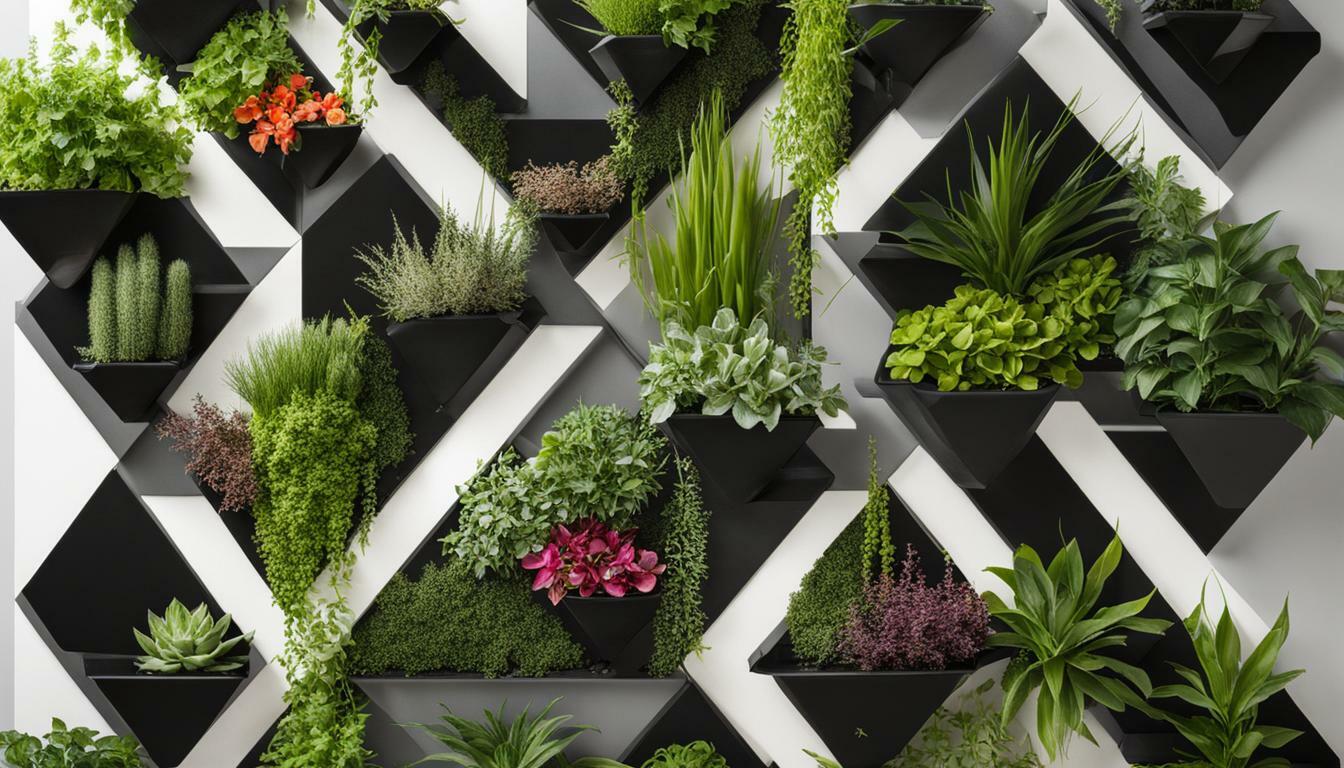Discover how a modern vertical garden can revolutionize your space and enhance your urban living experience. With innovative designs and creative techniques, vertical gardening is transforming the way we think about gardening in small spaces. Whether you live in a bustling city or have limited mobility, a vertical garden offers a green revolution that allows you to bring nature into your living environment.
Key Takeaways:
- Modern vertical gardens are innovative designs that maximize small spaces and transform living environments.
- Vertical gardening is ideal for urban living, providing a green revolution in limited spaces.
- Vertical gardens offer benefits such as conserving space and resources, enhancing accessibility, and promoting biodiversity.
The Benefits of Vertical Gardening
Vertical gardening offers a range of benefits, from maximizing small spaces to providing accessibility for those with limited mobility. It is an innovative way to transform living spaces and create beautiful and innovative ways to grow, display, and cultivate plants. This practice is gaining popularity among urban gardeners, as it allows for gardening in limited spaces such as balconies and rooftops. With the increasing world population and environmental changes, vertical gardening helps mitigate air pollution, increase biodiversity, and improve the quality of life by providing urban populations with more natural spaces to enjoy.
For gardeners with limited mobility, vertical gardening offers greater accessibility by raising plants off the ground and creating a more easily workable space. It not only conserves space but also conserves resources like water and fertilizer. By utilizing vertical space, gardeners can make the most of small areas and maximize greenhouse space.
One of the innovative ways to practice vertical gardening is by using trellises as a versatile and space-saving method for growing vining plants. Trellises can be used to grow various plants, including roses, jasmine, and vining vegetables such as tomatoes and peppers. They not only provide visual appeal but also create privacy and shade in outdoor living spaces. Trellises also offer the advantage of keeping plants off the ground, limiting their accessibility to pests and minimizing the risk of fungal and bacterial diseases.
Another space-saving and resource-efficient method of vertical gardening is using stackable planters. These containers allow for the creation of movable gardens and are great for urban living. Stackable planters maximize growing space by concentrating the use of soil, water, and fertilizer in containers sized ideally for growing small vegetables, herbs, and fruits. They are also a great option for individuals with limited mobility as they can be placed on rolling planter movers, making them easy to move and rotate for optimal plant growth.
| Trellises | Stackable Planters |
|---|---|
| • Versatile method for growing vining plants • Provides visual appeal and privacy • Ideal for growing roses, jasmine, and vining vegetables | • Space-saving and resource-efficient containers • Moveable gardens • Suitable for small spaces and urban living |
In addition to trellises and stackable planters, terraced gardening is another practical farming method for managing diverse plants in limited space. This ancient technique involves building terraces into the sides of hills or structures and allows for the cultivation of a variety of plants with different needs. Terraced gardens prevent soil erosion, increase nutrient retention, and streamline irrigation, making them a valuable option for managing limited space and creating a visually appealing garden.
Hanging containers are an easy and low-cost method for vertical gardening. They can be hung from railings, ceilings, or walls, making them ideal for small gardens. Hanging containers provide additional growing space for small plants like herbs, flowers, and edible plants like strawberries. They are a great way to add greenery to tight spaces and can be easily moved and rearranged to create different visual and functional arrangements.
Vertical gardening also offers a world of DIY possibilities, from wall-mounted planters to hanging terrariums and upcycled pallet gardens. These creative designs allow for personalized vertical gardens that are both functional and aesthetically pleasing. DIY vertical gardens make use of readily available materials and provide a fun and rewarding project for gardening enthusiasts.
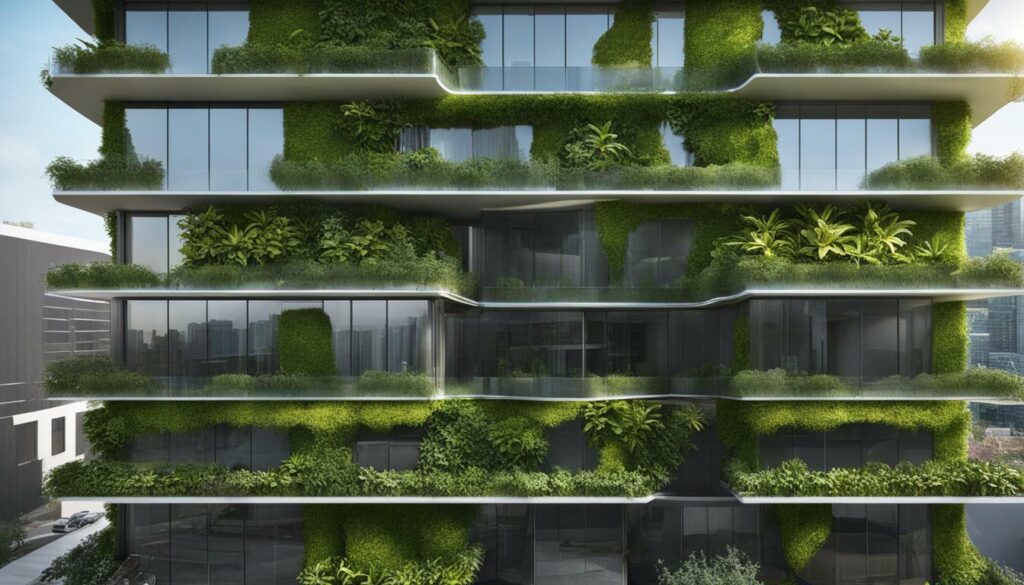
In summary, vertical gardening revolutionizes the way we utilize space and cultivate plants. It maximizes small spaces, provides accessibility for those with limited mobility, and conserves space and resources. Whether it’s by using trellises, stackable planters, terraced gardening, hanging containers, or DIY designs, vertical gardening offers endless possibilities for transforming any space into a thriving and beautiful garden.
Sources
- “Vertical Gardening 101” – Gardening Houseplants
- “31 Unique Vertical Garden Ideas” – The Spruce
- “Creating a Vertical Vegetable Garden with Pallets” – Green Thumb Revolution
Trellises: Versatile and Space-Saving Vertical Gardening
Trellises are a versatile and space-saving solution for growing vining plants in your modern vertical garden. They provide a sturdy support system for plants to climb and can be used in a variety of settings, from balconies to backyard gardens. With trellises, you can create a beautiful and functional garden that maximizes your growing space while adding privacy and visual appeal.
One of the advantages of using trellises in vertical gardening is their ability to accommodate a wide range of vining plants. Whether you dream of a wall covered in fragrant roses or a lush display of climbing vines, trellises can make it happen. They provide the perfect structure for vining plants to grow and thrive, allowing you to create a stunning vertical garden that transforms your space.
Aside from their decorative value, trellises also offer practical benefits for compact gardening. By training plants to grow vertically on a trellis, you can conserve space and prevent overcrowding. This is particularly beneficial for small gardens where every inch of space matters. Additionally, trellises can help protect vining plants from pests by keeping them off the ground and out of reach.
When choosing a trellis for your vertical garden, consider the size and strength of the plants you wish to grow. Some vining vegetables, like tomatoes and cucumbers, require sturdier trellises to support their weight. On the other hand, delicate flowering vines may only need a lightweight trellis for support. By selecting the right trellis for your plants, you can ensure their healthy growth and maximize the visual impact of your vertical garden.
Benefits of Trellises for Vertical Gardening:
- Provides support for vining plants to grow vertically
- Maximizes growing space in small gardens
- Creates privacy and adds visual appeal to outdoor spaces
- Protects plants from pests and disease
- Accommodates a wide variety of vining plants, from flowers to vegetables
| Trellis Material | Pros | Cons |
|---|---|---|
| Wood | Provides a natural aesthetic, easy to customize and paint | May require regular maintenance to prevent rot or warping |
| Metal | Durable and long-lasting, resistant to rot and weather damage | May heat up in direct sunlight, potentially damaging delicate plants |
| Bamboo | Environmentally friendly and sustainable, lightweight and easy to work with | May require additional support for heavier plants |
“Trellises are a versatile and space-saving solution for growing vining plants in your modern vertical garden.”
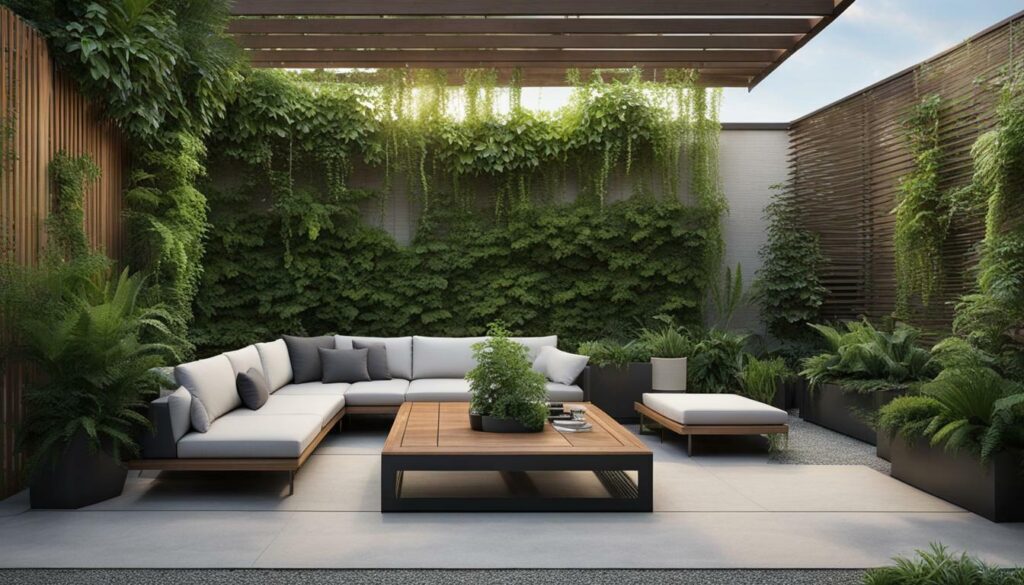
Trellises offer a practical and aesthetically pleasing way to create a vertical garden that transforms your space. Whether you’re growing flowers, vegetables, or a combination of both, trellises provide the support and structure needed for vining plants to thrive. With a wide range of materials and designs to choose from, you can find the perfect trellis to suit your garden style and preferences. Embrace the green revolution and revolutionize your space with a modern vertical garden enhanced by the versatility and space-saving benefits of trellises.
Stackable Planters: Space-Saving and Resource-Efficient Vertical Gardening
Create a moveable garden with stackable planters, the space-saving and resource-efficient solution for your modern vertical garden. Stackable planters, such as the Greenstalk 7 Tier Vertical Planter, are designed to maximize growing space while conserving resources like soil, water, and fertilizer. These containers are perfect for urban living, where space is limited and gardening opportunities may be restricted.
Stackable planters are not only practical but also visually appealing. With their compact and tiered design, they provide a beautiful display of plants in a small footprint. Whether you want to grow herbs, vegetables, or flowers, stackable planters offer a versatile and customizable solution.
One of the key advantages of stackable planters is their mobility. You can easily move them around your garden or balcony to optimize sunlight exposure and create different arrangements. This flexibility allows you to adapt your garden to changing seasons or experiment with different plant combinations.
“Create a moveable garden with stackable planters, the space-saving and resource-efficient solution for your modern vertical garden.”
In addition to their space-saving design, stackable planters are resource-efficient. By concentrating the use of soil, water, and fertilizer in compact containers, you can reduce waste and ensure that your plants receive exactly what they need. This not only benefits the environment but also promotes healthy plant growth.
Using stackable planters in your vertical garden is a practical and efficient way to grow a wide variety of plants. Whether you have limited space, want to maximize your gardening potential, or simply enjoy the aesthetic appeal of a vertical garden, stackable planters offer a solution that is both functional and visually appealing.
Benefits of Stackable Planters:
| Benefits | Description |
|---|---|
| Space-saving | Maximize your growing space with vertical stacking |
| Resource-efficient | Conserve soil, water, and fertilizer by using compact containers |
| Customizable | Create your own arrangement and easily move plants around |
| Mobile | Moveable garden solution that allows for optimal sunlight exposure |
| Versatile | Grow a wide variety of herbs, vegetables, and flowers |
With stackable planters, you can transform your space into a thriving vertical garden that is not only beautiful but also practical. Embrace the green revolution and revolutionize your gardening experience with these innovative and space-saving containers.
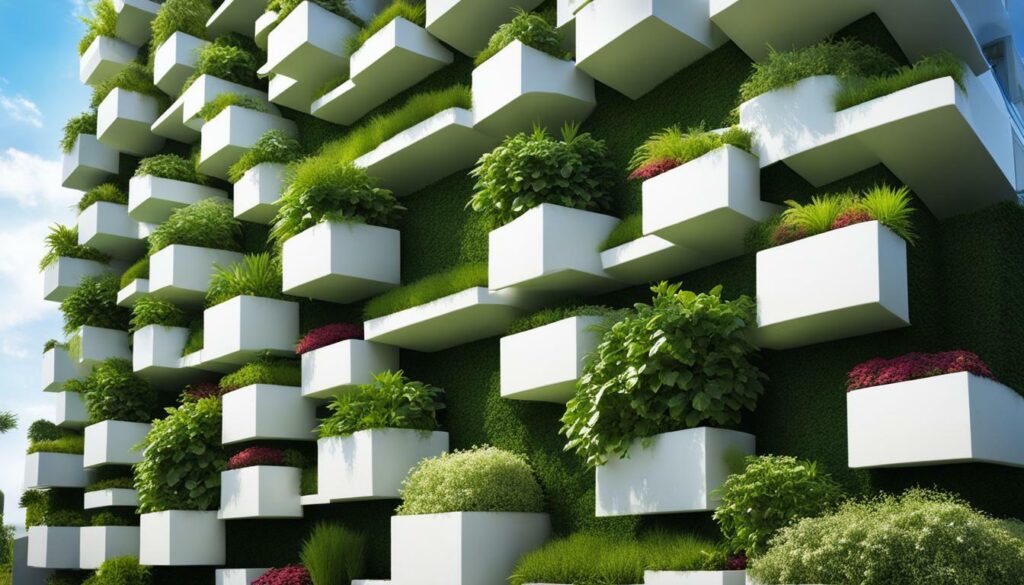
Sources:
1. Vertical Gardening: A Complete Guide to Growing Vegetables, Fruits, Herbs, and Flowers in Small Spaces
2. The Benefits of Vertical Gardening: Horticulture Therapy for Small Spaces
3. Green Revolution: How Stackable Planters Are Transforming Urban Gardening
Terraced Gardening: Managing Diverse Plants in Limited Space
Discover the art of terraced gardening, a practical farming method for managing a variety of plants in limited space. Terraced gardens have been utilized for thousands of years, adapted by ancient civilizations to cultivate crops on sloping terrains and uneven landscapes. In modern times, terraced gardening is gaining popularity among gardeners who are looking to maximize their growing space and create visually stunning outdoor areas.
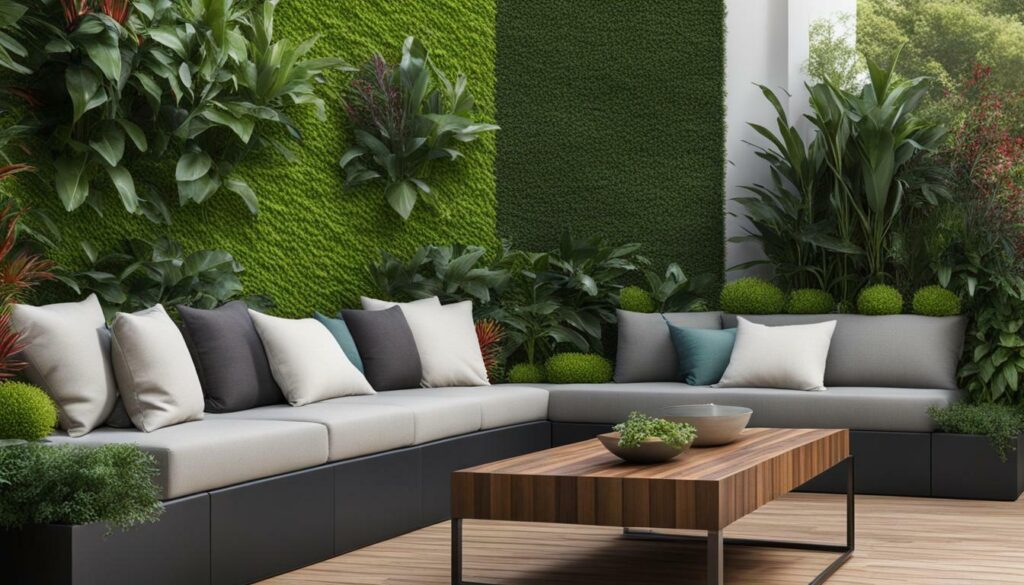
Terraced gardening is an effective solution for those with limited gardening space. By utilizing the natural slope of the land, terraced gardens create multiple levels of planting areas, allowing for the cultivation of a diverse range of plants. This method prevents soil erosion, maximizes water retention, and provides optimal conditions for each plant’s specific needs.
One of the key advantages of terraced gardening is its ability to manage diverse plants in a limited space. Each terrace can be dedicated to different types of plants, accommodating their specific lighting, soil, and water requirements. This allows for the cultivation of a variety of crops, herbs, flowers, and even small trees in a small area, creating a vibrant and thriving garden.
Additionally, terraced gardens offer practical benefits beyond their aesthetic appeal. The stepped structure of the terraces makes gardening tasks more accessible, reducing the strain on the back and knees. It also minimizes the risk of soil compaction and facilitates better drainage, preventing waterlogged roots. This makes terraced gardening not only visually appealing but also highly functional.
Benefits of Terraced Gardening:
| Benefits | Description |
|---|---|
| Prevents Soil Erosion | Terraced gardens help retain soil on slopes, preventing erosion caused by heavy rainfall or wind. |
| Optimizes Water Retention | The stepped design of terraced gardens allows water to be absorbed and retained, maximizing irrigation efficiency. |
| Accommodates Diverse Plants | The different levels of terraces provide suitable environments for various types of plants, allowing for a diverse garden. |
| Enhances Accessibility | The stepped structure of terraces makes gardening tasks more accessible, reducing strain on the body. |
| Improves Drainage | The design of terraced gardens facilitates better drainage, preventing waterlogging and root rot. |
Whether you have limited gardening space or simply want to create a visually striking garden, terraced gardening is a fantastic solution. By harnessing the natural landscape, you can transform a sloping terrain into a thriving oasis of plants. Embrace the art of terraced gardening and experience the joy of growing a diverse range of plants even in limited spaces.
Hanging Containers: Easy and Low-Cost Vertical Gardening
Transform your space with hanging containers, the easy and low-cost solution for vertical gardening. Hanging containers offer a practical and efficient way to maximize your gardening area while adding a touch of beauty to your surroundings. Whether you have limited outdoor space or want to bring the green revolution indoors, hanging containers are the perfect choice.
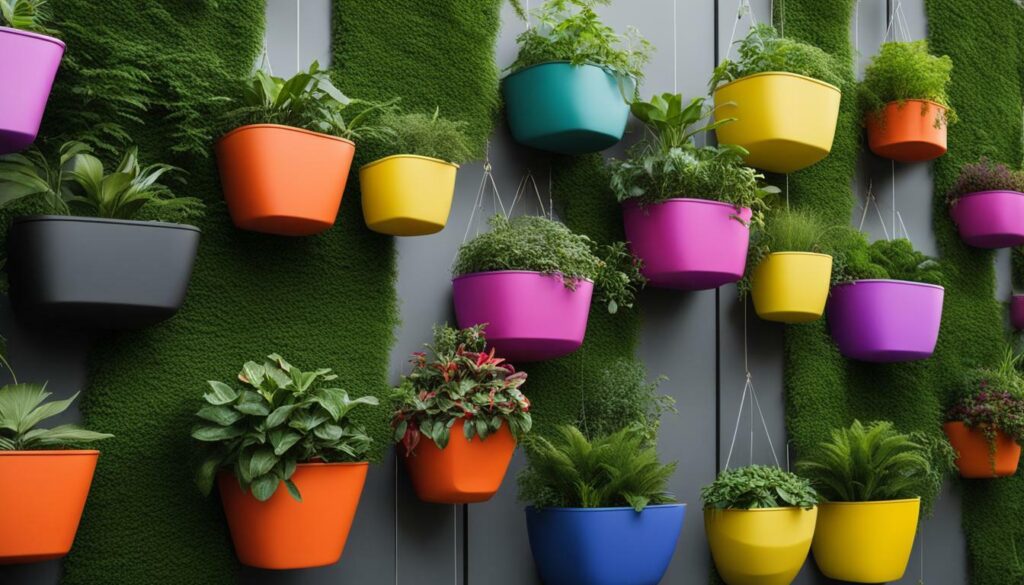
With hanging containers, you can create a lush garden even in the smallest of spaces. These containers can be suspended from railings, ceilings, and walls, providing a vertical growing space for a variety of plants. From vibrant flowers to herbs and vegetables, you can grow a wide range of plants in hanging containers.
Hanging containers are not only easy to set up, but they are also cost-effective. You can repurpose old containers or use affordable materials to create your hanging garden. By using hanging containers, you eliminate the need for large plots of land and can start gardening with minimal investment.
One of the advantages of hanging containers is their versatility. You can mix and match different types of plants to create a visually appealing display. Whether you want to grow a colorful arrangement of flowers or a practical herb garden, hanging containers allow you to customize your space to suit your gardening needs.
Benefits of Hanging Containers:
1. Space-Saving: Hanging containers utilize vertical space, making them perfect for small gardens or indoor areas with limited space.
2. Easy Gardening: Hanging containers are easy to maintain and care for. You can easily water, fertilize, and prune your plants without bending over or kneeling.
3. Low-Cost: Hanging containers can be made from affordable materials or repurposed containers, making them a budget-friendly option for vertical gardening.
Tips for Successful Hanging Container Gardening:
- Choose the Right Plants: Select plants that are suitable for hanging containers and consider their sunlight and water requirements.
- Proper Watering: Ensure proper drainage in your hanging containers to prevent overwatering and root rot.
- Regular Maintenance: Regularly check your hanging containers for pests, diseases, and any signs of stress in the plants.
- Rotate Plants: Rotate your plants every few weeks to ensure even growth and prevent one side from becoming overshadowed.
- Fertilize as Needed: Use a balanced fertilizer to provide essential nutrients to your plants and promote healthy growth.
With hanging containers, you can create a beautiful and productive garden in any space. Whether you want to grow flowers, herbs, or vegetables, hanging containers offer a practical and cost-effective solution for vertical gardening. So, start transforming your space today and embrace the green revolution with hanging containers.
| Benefits of Hanging Containers: | Tips for Successful Hanging Container Gardening: |
|---|---|
| 1. Space-Saving | Choose the Right Plants |
| 2. Easy Gardening | Proper Watering |
| 3. Low-Cost | Regular Maintenance |
| Rotate Plants | |
| Fertilize as Needed |
DIY Vertical Garden Ideas: From Wall-Mounted Planters to Hanging Terrariums
Get creative with these DIY vertical garden ideas, from wall-mounted planters to hanging terrariums and upcycled pallet gardens. Vertical gardening is a popular and innovative way to maximize small spaces and create stunning displays of natural beauty. Whether you’re a plant lover with limited gardening space or simply looking to add more visual interest to your home or yard, these DIY ideas are sure to inspire.
One of the easiest ways to incorporate vertical gardening into your space is through wall-mounted planters. These can be purchased at home decor shops or nurseries, or you can make your own using old containers and mounts. Wall-mounted planters not only add a touch of greenery to your walls but also save valuable floor space. Just make sure to remove them from the wall when watering to prevent any damage.
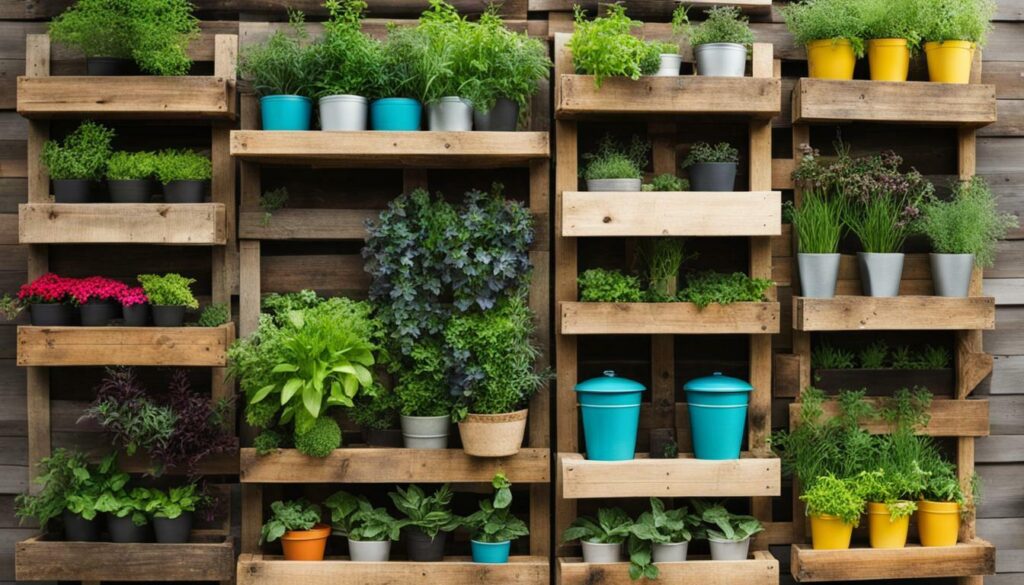
Hanging terrariums are another creative and whimsical option for your vertical garden. These glass containers can be hung from the ceiling or mounted to the wall, creating a stunning display of air plants or other humidity-loving plants. Propagation stations, moss-covered kokedama balls, and wire-mounted plant boards are other unique ideas to explore.
If you’re looking to repurpose materials and be eco-friendly, consider using upcycled pallets for your vertical garden. Pallet garden walls are not only visually appealing but also sustainable. Attach small planters like metal buckets or terra-cotta pots to the pallet, fill them with soil, and lay the pallet flat. This method allows you to grow a variety of plants while saving space.
Remember to plan out your vertical garden carefully, considering factors like location selection, plant choice, and support systems. Raised garden beds, trellises, terraces, living walls, and succession planting are all techniques that can be incorporated into your vertical garden, depending on your specific needs and preferences.
| Vertical Garden Ideas | Benefits |
|---|---|
| Wall-Mounted Planters | – Save floor space – Add visual interest to walls – Easy to customize and maintain |
| Hanging Terrariums | – Whimsical and eye-catching – Ideal for air plants and humidity-loving plants |
| Upcycled Pallet Gardens | – Eco-friendly and sustainable – Perfect for small spaces – Easy to create and customize |
| Propagation Stations | – Fun way to display new plant creations – Great for rooting and observing root development |
With these DIY vertical garden ideas, you can transform even the smallest spaces into a vibrant and green oasis. Whether you choose to hang planters on the wall, create a hanging terrarium, or repurpose pallets, the possibilities are endless. So get creative and start building your own vertical garden today!
Tips for Successful Vertical Gardening
Set yourself up for success with these tips for successful vertical gardening, from selecting the right location to choosing the right plants and support systems.
When it comes to vertical gardening, location selection is crucial. Whether you plan to grow your garden indoors or outdoors, make sure the chosen location receives adequate sunlight. Most plants require at least six hours of direct sunlight each day to thrive. If you’re limited on outdoor space, consider balconies, rooftops, or even walls with plenty of natural light.
Next, the right plant choice can make or break your vertical garden. Not all plants are suitable for vertical growth, so it’s important to do your research beforehand. Look for plants that have a climbing or trailing growth habit, as they are more suited for vertical arrangements. Popular choices include vining plants like tomatoes, cucumbers, beans, and ornamental climbers like jasmine and roses.
Support systems are essential for successful vertical gardening. Trellises, arbor-like structures, and wire mesh panels are excellent options for providing support to climbing plants. These structures not only help the plants grow vertically but also add visual appeal to your garden. Remember to choose sturdy support systems that can withstand the weight of mature plants and consider the spacing between the support and the wall to allow proper airflow.
Additionally, consider incorporating raised garden beds, stackable planters, or living walls into your vertical garden design. These space-saving and resource-efficient techniques can maximize your growing space and create a lush and beautiful display. Raised garden beds are particularly beneficial for those with limited mobility, as they minimize the need for bending or kneeling while tending to your plants.
Remember, successful vertical gardening is all about finding the right balance between plant selection, location, and support systems. By following these tips and experimenting with different techniques, you can create a thriving vertical garden that adds beauty and greenery to even the smallest of spaces.
Gardening Tips in a Nutshell:
- Select a location with adequate sunlight for your vertical garden.
- Choose plants with climbing or trailing growth habits.
- Consider using support systems like trellises or wire mesh panels.
- Explore space-saving techniques such as raised garden beds and stackable planters.
Table: Recommended Plants for Vertical Gardening
| Plant | Growth Habit | Best Support System |
|---|---|---|
| Tomatoes | Vining | Trellis or wire mesh panel |
| Cucumbers | Vining | Trellis or arbor |
| Beans | Climbing | Trellis or arbor |
| Jasmine | Trailing | Wire mesh panel or hanging container |
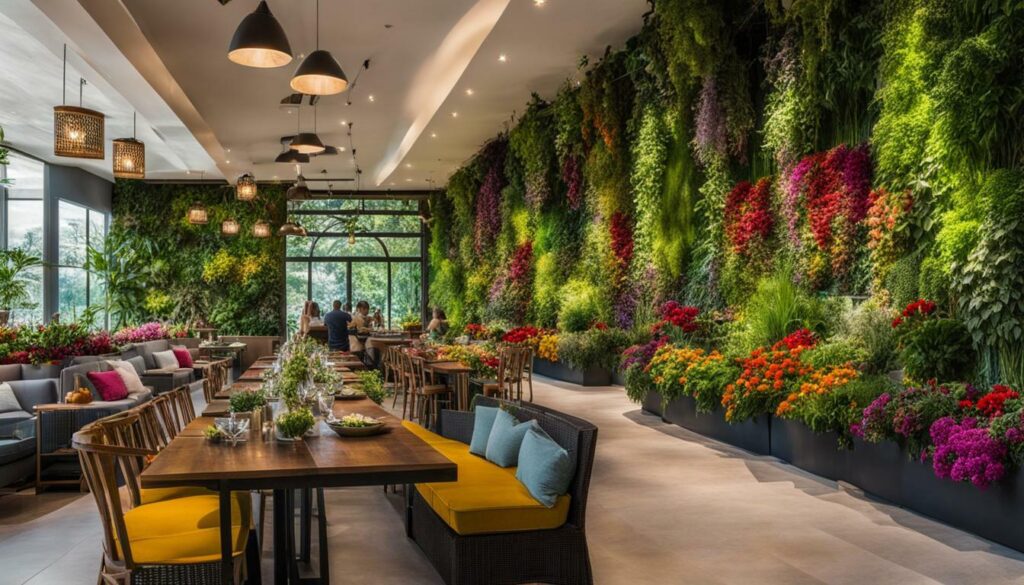
“Vertical gardening offers a creative and efficient way to transform small spaces into stunning displays of natural beauty. By selecting the right location, choosing suitable plants, and implementing proper support systems, anyone can achieve success in vertical gardening.” – Gardening Expert
Vertical Gardening Techniques for Small Spaces
Discover vertical gardening techniques designed specifically for small spaces, from raised garden beds to using pallets and trellises. These innovative methods allow you to maximize your gardening potential, even in limited areas.
One effective technique for small-space gardening is using raised garden beds. These beds provide a contained area for growing plants and offer several benefits. They prevent soil compaction and water runoff, minimize weed growth, and make it easier to work, water, and fertilize your plants. Raised garden beds can be placed on slopes, aligning them with the natural contours of the landscape, allowing you to create a functional garden that suits the incline of your property.
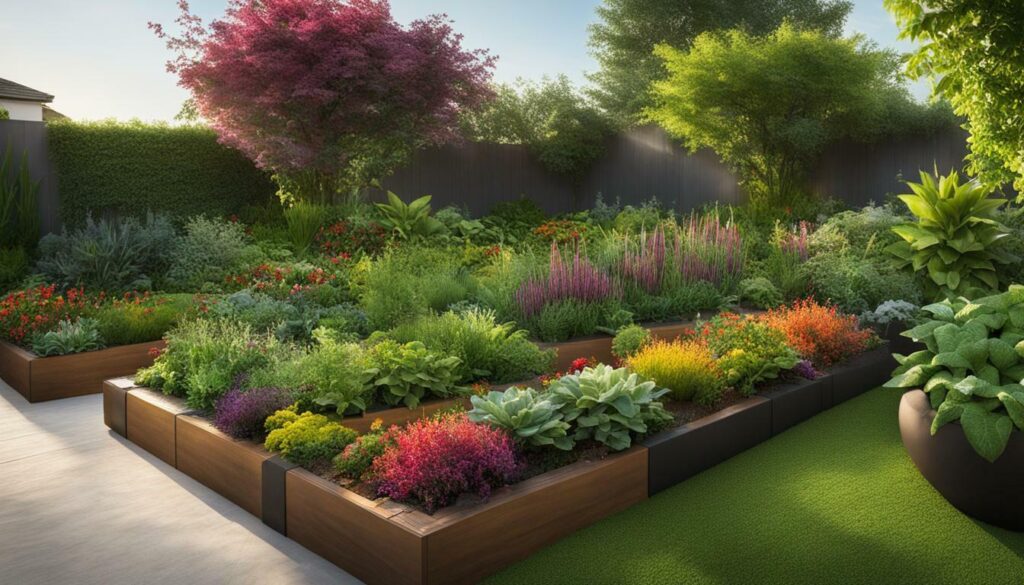
Another space-saving technique is using pallets to create a wall planting system. This eco-friendly approach repurposes materials and allows you to cultivate a vertical vegetable garden. Start by removing any nails or staples from the pallet and smoothing out uneven areas. Then, fasten small planters such as metal buckets or terra-cotta pots to the pallet with screws or nails. Fill the planters with soil and lay the pallet flat. This method provides a visually appealing and space-efficient way to grow your favorite vegetables.
Trellises are versatile and practical for small-space vertical gardening. They can be constructed using various types of wood, such as bamboo, which is known for its durability and sustainability. Trellises provide support for climbing plants, giving them ample room to grow and preventing mess caused by their spreading tendencies. Additionally, trellises enhance the aesthetic appeal of your garden and make it easier to harvest your crops.
Finally, hanging containers are an easy and low-cost method for vertical gardening in small spaces. They offer flexibility as they can be suspended from railings, ceilings, or walls, making them ideal for limited areas. Hanging containers are suitable for growing shallow-rooted plants like strawberries or salad greens, adding both beauty and functionality to your garden.
| Gardening Technique | Benefits |
|---|---|
| Raised garden beds | – Prevent soil compaction and water runoff – Minimize weed growth – Easy to work, water, and fertilize plants |
| Pallet wall planting system | – Repurposes materials – Creates an eco-friendly vertical vegetable garden |
| Trellises | – Provides support for climbing plants – Enhances garden aesthetics – Easier harvest |
| Hanging containers | – Low-cost and easy method for small spaces – Suitable for shallow-rooted plants |
These vertical gardening techniques offer a range of options for small-space gardeners, allowing you to transform limited areas into thriving and visually appealing gardens. Whether you choose raised garden beds, pallets, trellises, or hanging containers, you can enjoy the benefits of fresh produce and beautiful plants, even with limited space.
Conclusion
In conclusion, modern vertical gardening has the power to transform spaces with its innovative designs and sustainable approach to urban living. With the increasing popularity of vertical gardens, individuals can revolutionize their living spaces, whether in small urban apartments or limited outdoor areas. These gardens offer numerous benefits, including maximizing small spaces, providing accessibility for individuals with limited mobility, and conserving resources like water and fertilizer.
One effective method of vertical gardening is the use of trellises, which offer versatility and space-saving solutions for growing vining plants. Trellises not only provide visual appeal and privacy but also allow for the cultivation of fresh vegetables and fruits in limited spaces. Stackable planters are another space-saving option, allowing for easy mobility and resource efficiency.
Terraced gardening, an ancient farming method, proves to be a practical approach for managing diverse plants in limited spaces. By utilizing the natural slope of the land, terraced gardens prevent soil erosion and provide a visually appealing solution for gardening on uneven terrains.
Hanging containers offer an easy and low-cost method for vertical gardening, perfect for those who have limited space or want to add greenery to their indoor areas. Additionally, DIY vertical garden ideas, such as wall-mounted planters and hanging terrariums, provide creative and customizable solutions using upcycled materials.
To ensure successful vertical gardening, it is crucial to consider factors such as location selection, plant choice, and support systems. By following these tips and guidelines, individuals can create thriving vertical gardens that transform their spaces and contribute to the green revolution of urban living.
How Can I Implement the Vertical Garden System in My Space?
Whether you have limited outdoor space or simply want to bring greenery indoors, you can revolutionize your space with a vertical garden. By utilizing the vertical space on walls or fences, you can grow a variety of plants and herbs, creating a unique and aesthetically pleasing garden wherever you are.
FAQ
Q: What is vertical gardening?
A: Vertical gardening is an innovative gardening technique that involves maximizing small spaces by growing plants vertically, either by utilizing upright growth habits or containers. This technique can be applied both indoors and outdoors, making it ideal for those with limited space.
Q: What are the benefits of vertical gardening?
A: Vertical gardening has several benefits, including maximizing small spaces, providing accessibility for individuals with limited mobility, conserving space and resources like water and fertilizer, and increasing airflow to minimize the risk of fungal and bacterial diseases.
Q: How can trellises be used in vertical gardening?
A: Trellises are a versatile and space-saving method for growing vining plants in vertical gardens. They can be used to grow a variety of plants, from ornamentals like roses to fresh vegetables and fruits. Trellises also provide privacy, shade, and visual appeal.
Q: What are stackable planters and how can they be used in vertical gardening?
A: Stackable planters are space-saving and resource-efficient containers that can be used to create moveable gardens. They come in various colors and can be used to grow small vegetables, herbs, and flowers. Stackable planters are ideal for individuals with limited mobility and can be easily watered and moved.
Q: What is terraced gardening and why is it useful in limited spaces?
A: Terraced gardening is an ancient farming method that involves building terraces into the sides of hills or on the sides of dwellings. It is a practical way to manage diverse plants in limited space and prevent soil erosion. Terraced gardens are visually appealing, conserve water, and provide accessible gardening levels.
Q: How can hanging containers be used in vertical gardening?
A: Hanging containers are an easy and low-cost method for vertical gardening. They can be used to grow a variety of plants, including edible ones. Hanging containers are suitable for small gardens and can be suspended from railings, ceilings, or walls to save space.
Q: What are some DIY vertical garden ideas?
A: DIY vertical garden ideas include wall-mounted planters, hanging terrariums, and upcycled pallet gardens. These creative designs allow you to transform small spaces into stunning displays of natural beauty. They can be used both indoors and outdoors and are a great way to add visual interest to your decor.
Q: What are some tips for successful vertical gardening?
A: Some tips for successful vertical gardening include selecting the appropriate location that receives adequate sunlight, choosing the right plants for vertical growth, and deciding on an appropriate support system. Raised garden beds, using pallets, trellises, living walls, and succession planting are also effective techniques for small spaces.
Q: How can vertical gardening revolutionize small spaces?
A: Vertical gardening has the power to revolutionize small spaces by transforming them into innovative and visually stunning living areas. With modern designs and techniques, vertical gardens offer a green revolution for urban living, maximizing the use of limited space and providing a more natural and accessible environment.

